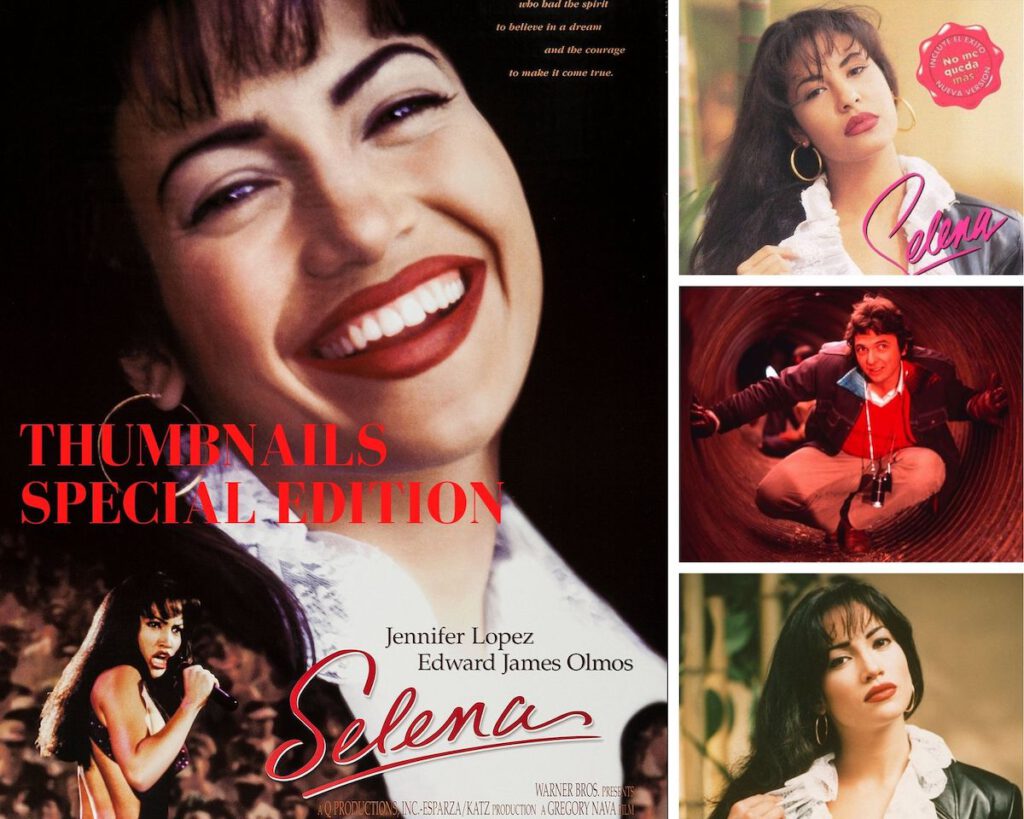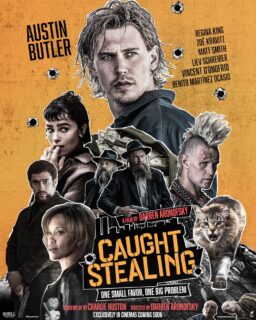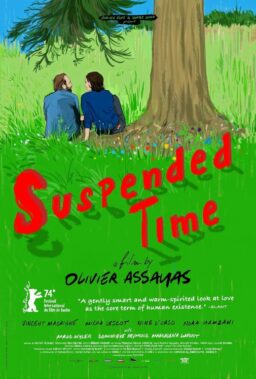Thumbnails is a roundup of brief excerpts to introduce you to articles from other websites that we found interesting and exciting. We provide links to the original sources for you to read in their entirety. As a way to celebrate what would have been Selena’s 50th birthday, April 16th, 2021, this special edition of Thumbnails celebrates filmmaker Gregory Nava and his 1997 biopic, “Selena.”
1.
“Selena“: Roger Ebert‘s original three-and-a-half star review of Gregory Nava’s 1997 biopic about celebrate Mexican-American singer Selena Quintanilla, who was murdered 26 years ago today.
When Lopez (and Selena) are left alone to simply sing, the results are electrifying. “Selena” is smart in not letting the singer’s death dominate the story of her life. We meet her killer, Yolanda Salvidar (Lupe Ontiveros), almost obliquely, when she’s introduced as the manager of Selena’s new boutique and the former president of her fan club. Soon there’s a discrepancy over missing money, and then the shooting, which the movie deals with only through its aftermath. “Selena” succeeds, through Lopez’s performance, in evoking the magic of a sweet and talented young woman. And, like Nava’s “My Family,” it’s insightful in portraying Mexican-American culture as a rich resource with its own flavor and character. It’s ironic that the most successful modern Latina singer could once have had a talk with her dad where he sighed, “You like Donna Summer, I like doo-wop.” But he also said, “You gotta be who you are.” She was.

2.
“Gregory Nava: Living in el Norte“: Two years prior to the release of “Selena,” the filmmaker spoke with Roger Ebert about his 1995 drama, “My Family,” which expands on the themes of immigrant life that were explored in Nava’s 1983 landmark, “El Norte.” Ebert gave four stars to “El Norte” in his original review and later inducted it into his Great Movies series.
“Chicanos haven’t had a lot of chance to work in the film industry, so you don’t have a lot of production designers and people you can work with. The visual genius of the community has gone into painting, and the most exciting painters in Los Angeles today are the Chicano painters. My favorite is named Patssi Valdez, and she does all these beautiful house interiors; they’re gorgeous paintings. So we actually hired her – she’d never worked on a movie before – to work with us to design the interior of the house. Vibrant way of life. So there are all these reds and purples and blues and all the vibrant colors, and they all come from her painting and reflect the vibrant reality of the way people decorate their houses in East Los Angeles. I wanted in the film to have this poverty reflect the beauty the people have and the pride they have in their homes. There’s a false dichotomy in the movies: If it’s rich it can be beautiful, but if it’s poor, it must be horrible and bleak. The reverse can also be true. I think Orson Welles had an interesting angle on wealth in ‘Citizen Kane,’ where it’s oppressive and horrible. In ‘My Family,’ it’s poor, but it is very beautiful, and I wanted to capture that in the film. I feel that there’s no reason why a plaster flamingo against a pink wall can’t be just as beautiful as anything in `The Age of Innocence.'”

3.
“Championing Independent Film: Gregory Nava on Roger Ebert“: Nava wrote the following essay for inclusion in the program book for the 2014 Spirit Awards, where Ebert was honored that March.
Roger Ebert loved independent films. He gave all us mavericks—the independents—filmmakers who had a different story to tell—an avenue to be seen and heard. Before there was a Sundance—before there was a Film Independent or an IFP—there was Roger. I still remember him bounding up the aisle of the Biograph
Theater in Chicago, hand extended to me saying: “Hello, my name is Roger Ebert and I loved your movie.” And you could fill the Biograph Theater many times over with filmmakers who had the same experience—Spike Lee, Michael Moore, Martin Scorsese, Barbara Kopple, Errol Morris and the list goes on and on. He was the first to support us—when it wasn’t the fashionable thing to do—and he helped open the floodgates that became independent filmmaking in America.

4.
“‘Selena’ at Ebertfest 2018“: RogerEbert.com Assistant Editor Nick Allen penned this festival dispatch that covered a 21st anniversary screening of Nava’s biopic, followed by a Q&A moderated by Monica Castillo and Claudia Puig (click here to view the photo journal from Ebertfest 2018).
When discussing the film, Nava shared how much of the script comes from real stories with Selena and her family, including the scene where Selena and her boyfriend Chris decide to elope. He did mention one scene that was very much his own idea, which is also one of the movie’s most powerful—a discussion that Edward James Olmos’ patriarch Abraham has with Selena and brother Abie about being Mexican-American. Nava shared that he’s always wanted a way to put that idea across, of not feeling Mexican or American enough as Mexican-American. As someone who was born on the border and grew up in San Diego but would go to Mexico “three times a week,” Nava said “that’s my reality.” It’s clear years later how much the film means to so many people, honoring Nava’s original goal of making a “universal human statement,” but featuring people who do not see themselves often represented in popular media. In sharing the moment he knew he wanted to make this film, Nava expressed that he was at first uncertain, but then he saw a couple of young Latinas who were wearing Selena shirts. When he asked them why they love Selena, they replied, “because she looks like us.”

5.
“Gregory Nava on ‘El Norte’“: Prior to a special theatrical screening of Nava’s 1983 masterpiece, the filmmaker revisited the film in an interview with RogerEbert.com Assistant Editor Matt Fagerholm. Ebert Fellow Carlos Aguilar also penned a personal reflection on the film entitled, “The Gold Cage Loses its Shine.”
The awareness “El Norte” raised for refugees feeling horrific violence in their homeland contributed to an atmosphere of compassion in this country that resulted in more humane laws. The Temporary Protected Status was passed for refugees in Central America, and the Simpson-Mazzoli Act subsequently legalized two million refugees in 1986. Both Walter Mondale and Ronald Reagan referred to “El Norte” when they had their presidential debates. 35 years after the film’s release, the situation hasn’t changed. It’s gotten worse. Our desire was to bring a heart and a soul to the shadows who pervade our country, doing all of our work—picking the fruits and vegetables, taking care of our children and sustaining our industries for things like poultry and construction. Immigration has become an integral part of our entire economy and how our country runs, yet the issue is continuously being framed through a racist lens. We still see huge raids occurring in states like Mississippi and Missouri. What is being overlooked here is the contribution these immigrants make to our society. You take away the undocumented from our towns and the towns die.











